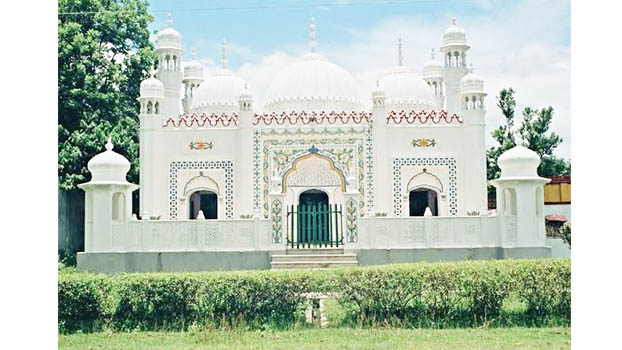Century old Prithimpassa Nawab Bari Mosque

Ali Hamid Khan
We are what ourheritage and history reveal. They tell us about the journeythrough time and space we cover to reach the present stage of development. The richness tells about our psyche and mind-set and our perspective. Man slowly and through great deal of struggle, innovation and creative endeavour develops the society and environment in which he lives. Bangladesh’s history has gone through many stages and phases and has come to this point where we are a respectable and developing country in the comity of nations. We have traversed through a long and rough road to become a nation and contribute to the development of the world. Our trajectory has not always been smooth. The landmarks we come across reveal and unfold our history and development.
Today I want to bring to focus an old monument which depicts history of the region and unfolds the heritage of the place. It is an old mosque built of lime mortar in the late nineteenth century belonging to Prithimpassa Nawab Bari in Prithimpassa, Moulvibazar. The architecture speaks volume and lays before the beholder the trend and designs which prevailed in the early twentieth century. This Mosque was built in the early 20th century just after the one built in the same place before it, in the Sultan era, was damaged. The older mosque was damaged during the 1897 earthquake along with other old buildings and structures of the family.
The one constructed before the present one had the architectural designs pertaining to the Sultan period which differed from the Mughalera. The present mosque is based on the Mughal designs with the domes and arches and arabesque patterns and motifs on the walls and pillars and the minarets. The small courtyard has two small minarets in the front. They are for the Muezzin to say the azan, the call to five time prayers.
To enter the Mosque you have to climb up the flights of stairs and through the arch enter the courtyard and then the ante chamber or the front space before the main hall where the Mussalis(those who stand in line to pray) say their prayers. The walls have different designs of motifs and arabesque patterns. The moment you set your sight on them you are filled with awe and a sense of serenity. The ceiling is high with three domes; the one in the middle is the large one with two smaller ones on both the sides. The minarets have motifs and volute patterns of leaves and flowers. Inside the hall is the Mehrab which is semi-circular niche indicating the Qibla(the west where the Imam stands and leads the prayer). There are two other niches where books and Qurans are kept for those who want to read. On the right hand side niche there is a big black stone tablet on which there is an Arabic inscription dating back to the time of The Sultan era.
During Sultan and Mughal periods, whoever built a mosque, this type of stone were used to inscribeas building mosques, according to Islam is considered a virtuous deed; those who build Mosques are rewarded in the hereafter. Quoting Allah’s words and praising Him and the Holy Prophet, the inscriptions are carved on the tablet.
This mosque stands in front of the main homestead of the Zamindaroverlooking the Dighi (Big Pond). The ambience is quiet and serene with a clear view of the paddy fields and the mountain in the distance. It is a tranquil and peaceful place inside the Mosque. The floor is decorated with red marble, with white and black marble chips sprinkled all over the floor. The floor stays cool at day time and the two tall windows on both sides keep the breeze circulating cooling the place on a hot day. It is an ideal place to be lost in prayers and meditation and reciting the tasbih (rosary).
Prithimpassa Nawab Bari’s Mosque has stood for more than a hundred years and if we consider the old one which was in its place prior to the devastating earthquake, it is as old as the family history dating back to the time of the Sultan era.



